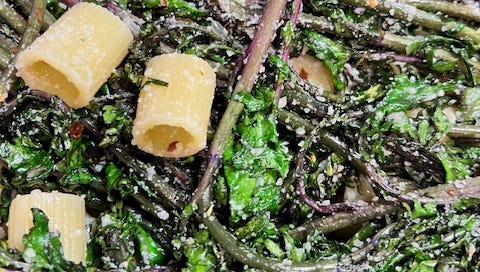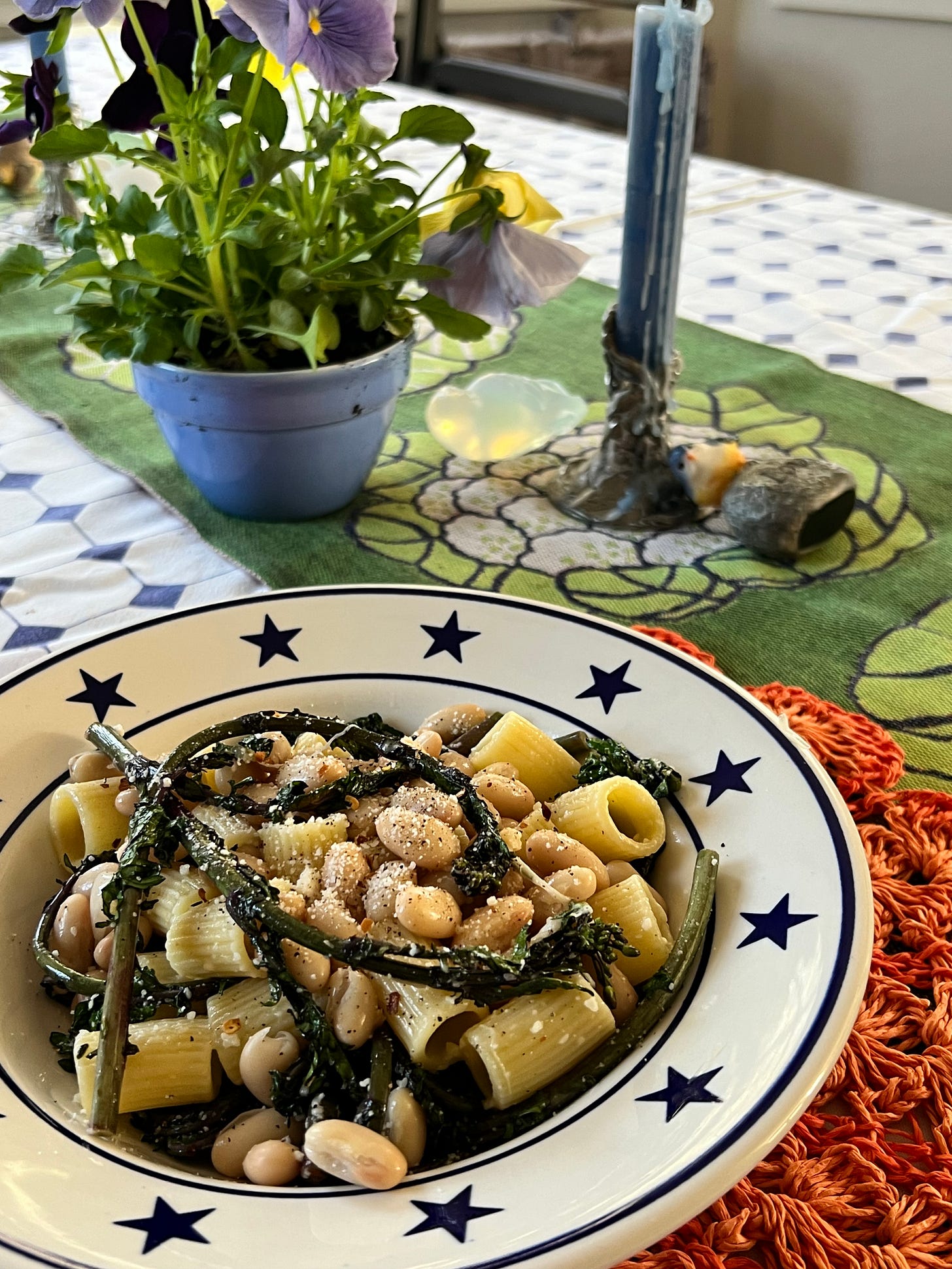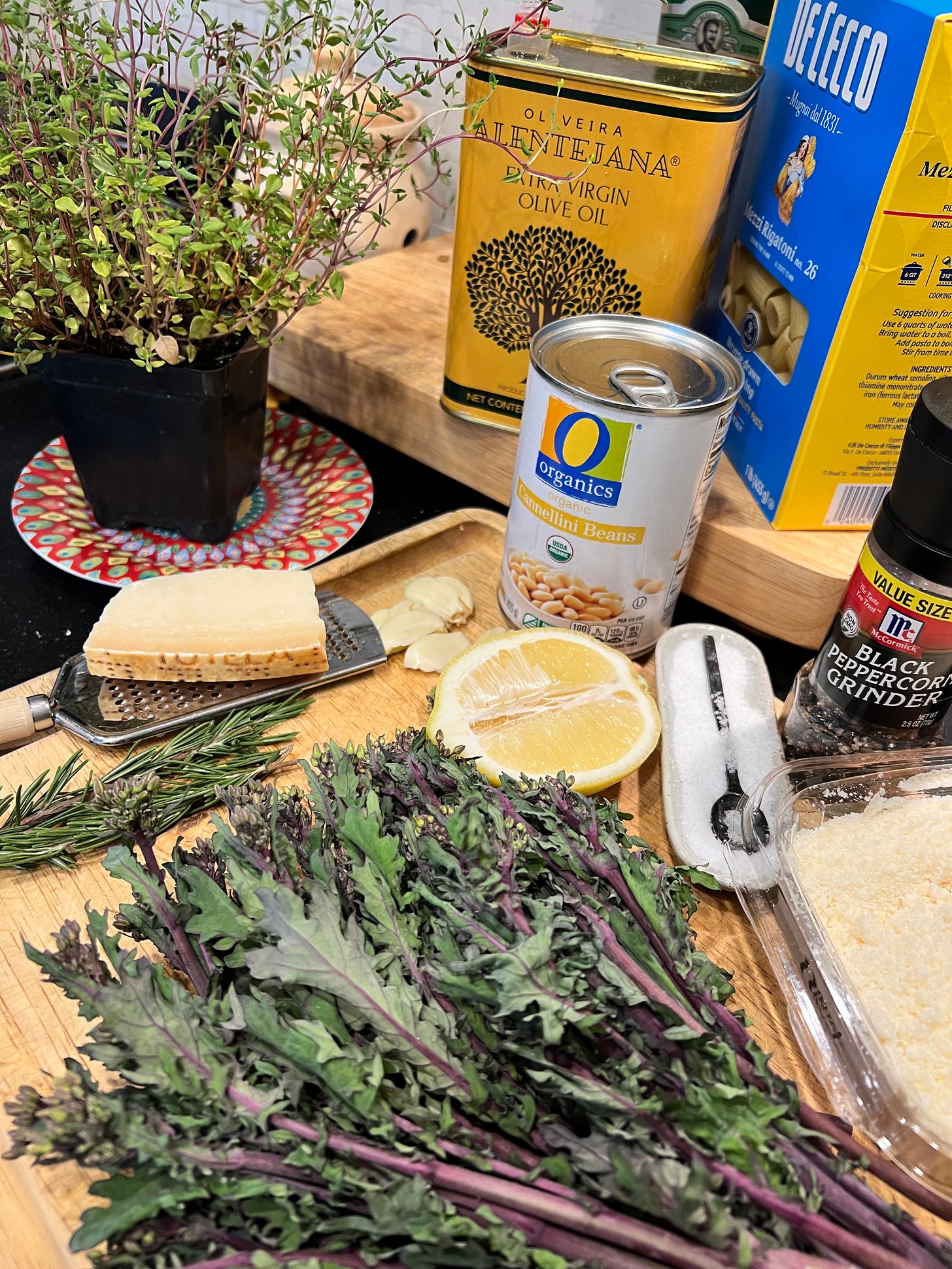Less dog paddling, more rest and contemplation
and pasta with spring kale florets, garlic, lemon and white beans
Some of our best ideas come when we are not looking for them. This past weekend we were reminded of this sentiment on Jane Pauley’s Sunday Morning show; the first segment entitled, “Take it easy: The importance of being lazy.” was especially interesting. Enter author Celeste Headlee, a recovering workaholic who prizes her slack time. As she tells her story, at 47 her health was questionable. Realizing it was the amount of time she was working, she quit her full time job, traveled for 2 weeks across the country on Amtrak and after a few days leaned into the solitude of not being plugged in enjoying the hidden virtues of laziness. She has written a book on the topic to explain that leisure time is necessary for our own health and wellbeing.
We are uncomfortable using the word lazy to describe ourselves. It may be one of the things growing up that we know not to embrace. We are conditioned in the United States and many other countries that hard work = value. We wanted to be valued. We may have watched our grandparents, parents, all people with whom we admired, work exceedingly hard for their life and lifestyle. We said, multiple times, to our children, you must work hard and you will be rewarded. We don’t personally know any parents that said, focus a few hours a day and the rest of the day is yours! If so, would our children have chosen a different path?
The key is focus. As the CBS segment unfolded and the researcher from MIT explained we can concentrate on one, maybe two ideas, it brought me back to the mid 2000’s. To my web design class, where we discussed all things related to tech including social media. Since the classes involved technology, students were in front of a computer and at any given time may have multiple screens open. Walking around the room some computer screens would be minimized. Hmm…what are you minimizing? Oftentimes it was their email or Myspace, and then Facebook, or a website that had the sports scores or song lyrics. A myriad of things really. What was consistent is all of the students reassuring me or maybe themselves that they could multitask. “Don’t worry, I am actually better when I have multiple screens going.” “I do this all the time at home. I have my music on, doing my homework, IMing my friends, and posting pictures”. Contrary to their beliefs, they were not good at doing multiple things well and with the new technology, they had no desire to focus on one thing.
Those of us who are successful in our capitalistic economy pride themselves at being available anytime, anywhere. We are all accessible because of the technology around us. Is anyone resting? Most likely the person who has availed themselves to multiple opportunities have been promoted in their field. Rest is not the priority, productivity is the priority in America and workers are rewarded for it. The same students who said they could multitask in class, who were encouraged by a culture of expectations in our economy, have most likely assured their current employers that they can multitask. Guess what, they can’t.
Back in 2010, the PBS Frontline series produced a documentary, Digital Nation. For the first time scientists, from Stanford University, used MRIs to study the brain imaging of students who were self-described “super multitaskers”. The results of the imaging showed that these students were slower at multitasking than when they did one thing at a time. The study concluded that people who were multitasking were prey to distractions: from checking email, to googling somebody or something, to checking a calendar, you see where this is going. Moreover these same multitaskers were worse at analytic reasoning. Fast forward to the present day and Dr. Earl Miller, neuroscientist, from the Picower Lab at MIT underscores the Stanford study’s results through his own work supporting that our brains are one-track. We can have one, maybe two thoughts; we are mostly single-minded. He explained that our brains are physically unable to multitask, we slow down and/or make mistakes. He suggests doing nothing at all and allowing our unconscious mind to have thoughts that bubble up. He encourages tuning out so these unconscious thoughts have the opportunity to arise. It has been 14 years and who knows how many studies in between and still people think they can multitask. Unfortunately, because we think we can or wish we could do something does not mean we can. We must have valid proof that shows the science that we can multitask. Otherwise, it is our opinion.
With all of the research to support that multitasking doesn't work and with scientists encouraging us to allow our unconscious mind to wander, and if the point is we want to be our most creative selves, not to distract ourselves, then why do we continue to do the thing that is not working? Here is my unscientific reason why: There is no reward for laziness in the business world. Further, our own social pressures make doing nothing hard, even on the weekends. Who can relate to finally sitting down, resting, maybe watching TV on the weekend after you did all the things you wanted to get done and hearing your spouse, parent, friend pull up outside and thinking,...yikes, do I get up, pretend I am doing something? Or better yet, they don’t say a thing because they are not thinking anything, but we list off all of the items we have just completed to show we have “earned” a rest. On the “Sunday Morning” Show, professor Lonnie Golden called it “conspicuous busyness.” I laughed at that phrase. But it hits.
We all need space for contemplation. Let's take it. Less dog paddling, more rest; for the science of it, if nothing else.
Take it easy and start with beans!
Recommended recipe:
Pasta with kale florets, lemon, and white beans—springtime in a bowl!
This comes together very quickly. Gather the ingredients. The longest thing is waiting for the pasta to cook. You can be sitting down to eat in 30 minutes.
Kale is highly nutritious and offers a variety of health benefits. In the spring in the northeast, Kale florets abound, and like the leaves, are rich in vitamins, minerals, and other beneficial compounds. Here are some key nutrients found in kale:
Vitamin K: Kale is one of the best sources of vitamin K, which is crucial for blood clotting and bone health.
Vitamin A: It is high in beta-carotene, an antioxidant that the body can convert into vitamin A, necessary for healthy skin and mucus membranes, as well as immune function.
Vitamin C: This essential nutrient supports immune function, skin health, and iron absorption.
Calcium: Important for bone health and plays a role in other cellular functions.
Iron: Essential for the formation of hemoglobin and enzymes, transporting oxygen to various parts of the body.
Fiber: Kale is a good source of fiber, which can help with digestion and maintaining a healthy gut.
Antioxidants: Contains powerful antioxidants like quercetin and kaempferol, which have anti-inflammatory effects and may help lower blood pressure and protect against heart disease and other conditions.
Kale florets, specifically, tend to be tender and can be cooked similarly to broccoli florets, offering a slightly sweeter taste compared to the leaves. I found these at the farmers market this weekend from Roots Farm and I thought I would cook them up like I would broccoli florets, sauteed with garlic, herbs, a little heat and lemon. The florets provide similar nutritional benefits as the rest of the plant, making them a healthy addition to our pasta dish. They were delicious!
If you plan on adding in the cannellini beans (aka white kidney beans) you can look forward to the following nutrients. This is for ½ cup of beans in your pasta per serving:
Protein: Around 7-8 grams, making them a good plant-based protein source.
Carbohydrates: About 20 grams, with a significant portion coming from dietary fiber.
Fiber: Approximately 6-8 grams, which is excellent for digestive health and can help regulate blood sugar levels.
Fat: Very low in fat, generally less than 1 gram per serving.
Iron: Provides about 2-3 milligrams, contributing to about 10-15% of the daily recommended intake.
Calcium: About 50-60 milligrams, which contributes to bone health.
Folate: Significant amounts of folate, important for DNA synthesis and during periods of rapid growth (like pregnancy).
Potassium: Around 300-400 milligrams, important for heart health and fluid balance within the body.
Ok, lets dig in:
Ingredients
3 cups kale florets include stems, leaves, etc. (My kale is purple but use whatever you have. I left it whole, intact. If you want to chop yours up go ahead. Personal preference.)
2-3 Tbsp EVOO
3 large cloves garlic, chopped (I love garlic, use less if you don’t)
2-3 tablespoons fresh herbs, chopped (I used rosemary and thyme-sometimes I have mint and parsley or sometimes none and it is just as good)
1 ½ cups cannellini beans from a can or previously cooked-rinsed
1/2 tsp salt
1/4 tsp pepper
juice from half a lemon
Zest from the lemon (you can zest right into the saute pan in a bit)
1/4 tsp or good pinch of red pepper flakes
Pasta of your choice, I had mezzi rigatoni
Pasta water (1/4 cup or more—I usually scoop up 1 cup to be sure I have enough)
½ cup grated parmesan cheese plus more for serving—I use the freshly grated parmesan reggiano from my local market (its like powder and melts easily into the pasta water)
Get a large pot, fill with water and turn on high to bring to a boil. Add salt to the boiling water. Once it is boiling, add pasta and cook to your liking. I like al dente because it will cook a bit longer in the cast iron pan later. Don’t forget to scoop out 1/2 cup of pasta water to add to the cast iron pan.
While the pasta is cooking, heat up a cast iron or saute pan with 2 T. olive oil for 1-2 minutes over medium heat. Add the garlic and herbs, saute 2-3 minutes stirring constantly as you don’t want the garlic to burn but you do want it to get golden.
Add the kale flowers, stems, all of it. The water from washing it will help it to cook as you add it to the oiled pan (you will hear a little crackling). Season with salt, pepper, and zest the lemon right on top of the kale, add the red pepper, mix it all in and cook for 3-4 minutes. **If the kale flowers are finished and the pasta is not, remove the kale flowers to a plate and wait for the pasta to finish cooking and then add back and continue adding the last T. of olive oil, pasta, etc.
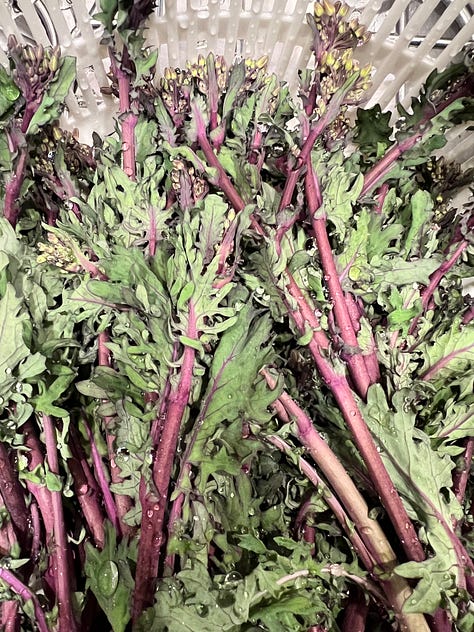
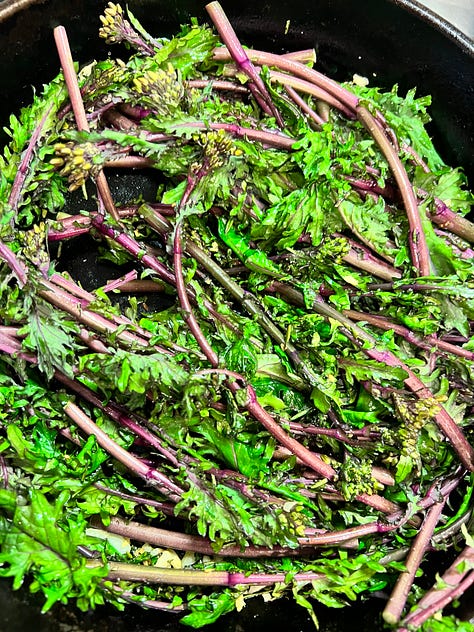
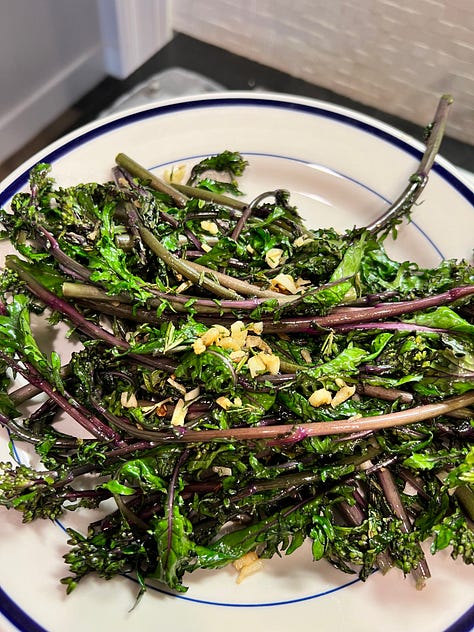
When the pasta is finished drain and add to your cast iron pan. I did not add all of my pasta. I added about 5 ladles full. A little more than two portions. Add the beans, lemon juice and ¼ cup of pasta water. Turn off heat. Add parmesan and stir. Return your kale florets back into the pan. Add more pepper, salt, crushed red pepper, and parmesan to taste. Enjoy!
Notes: I added my beans by individual portion as we have an allergy in the house to white beans. If not, I would have added the 1 1/2 C of beans right into the saute pan. I have also tried to add grated parmesan into the pasta water first and add that to the cast iron pan after the pasta has been stirred. No real difference.
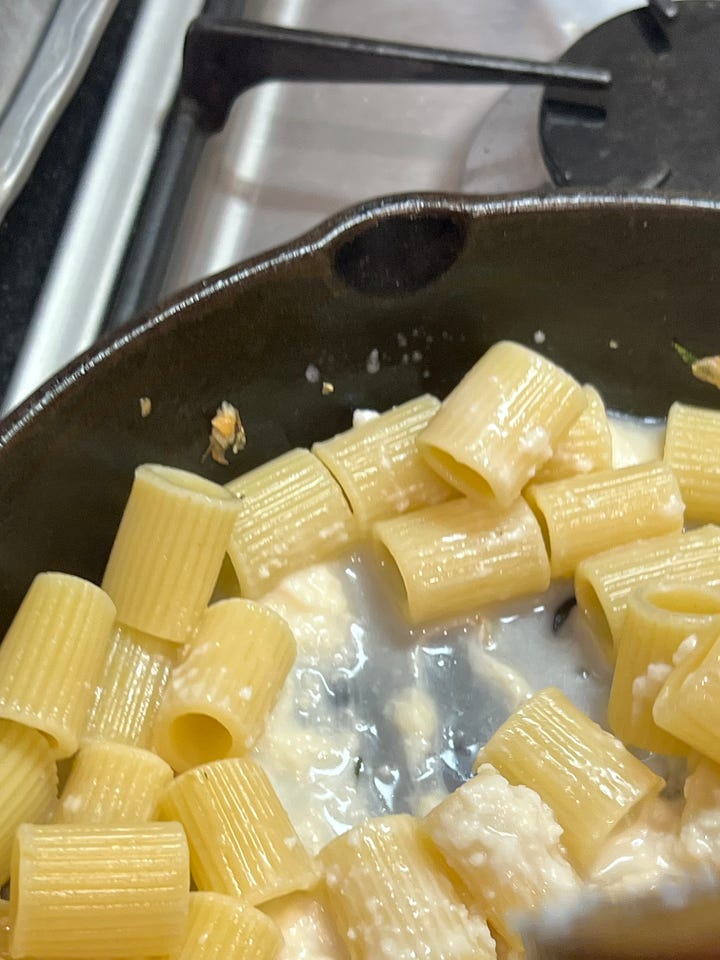
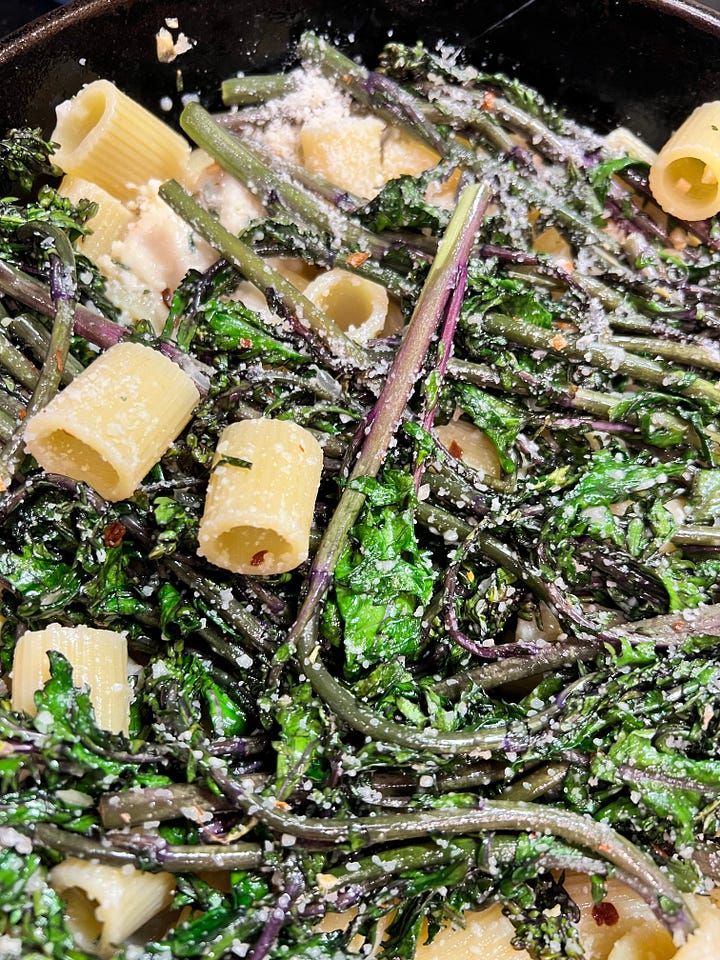
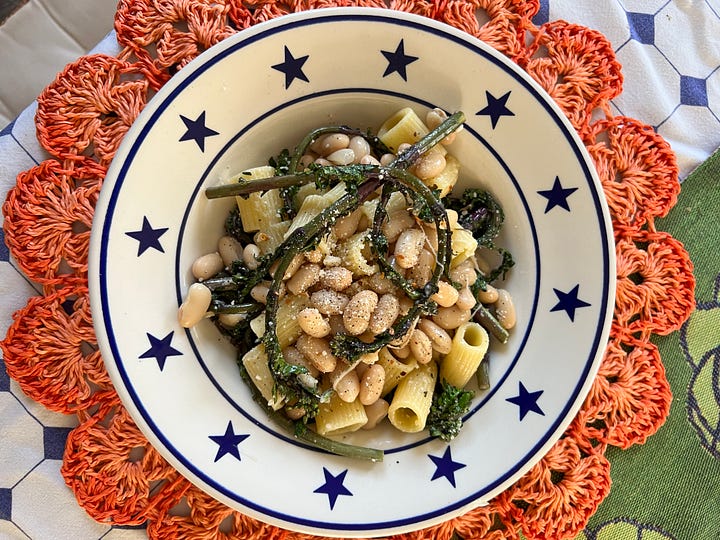
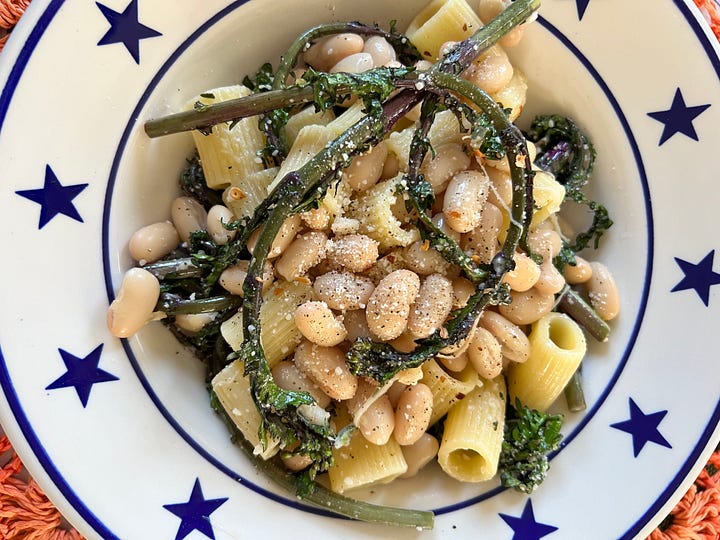
Contact
If you have any questions on integrating beans consistently for gut health now and into the near future, please email me at Denisemancieri1@gmail.com. Feel free to comment below if there are topics you would like to see.
Please share this newsletter with others if you find it may assist them in adding beans to their diet. Or click the heart, below left, so I know you were here. Thank you!
Note: I am not a doctor. I am a teacher and an educator with an earned doctorate in educational leadership. I enjoy research and I can distill large amounts of information into easily understood and digestible pieces allowing people to understand what is happening to their body and possible steps to reverse it with food as medicine. I have healed my own GI issues through choices with food. I followed Karen Hurd’s bean protocol diet, I meditated and still do and I healed. I feel compelled to be in service and educate others as the more people eating beans, alongside a healthy diet and sharing their stories the more people will live a healthier existence. Joy, peace and freedom abound. Please see your doctor and discuss nutritional options before you change any course of action with your health.
Remember to leave your comments below!

